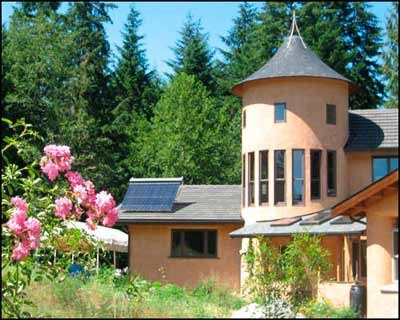It reminds me of the children’s story of the Three Little Pigs. One built a house out of bricks, one built a home out of sticks and one built a house out of straw. If you delve into techniques for green building you find lots of different options, just like they did. But you wonder if the Big Bad Wolf will be able to huff and puff and blow your house down!
A Green Building Seminar is set at Oak Harbor City Hall Tuesday, Feb. 14 at 5:30 p.m. Find out about the latest green building techniques and materials from Dan Neumeyer of Jade Craftsman Builders.
Building with cement, steel and board lumber has a tremendous cost to the planet. Cement, for instance, takes a tremendous amount of energy and pollutes air and water. In some cases, materials are shipped around the world, burning fossil fuels and producing carbon emissions.
In recent years, natural building materials have re-emerged as a local, renewable, inexpensive and sustainable option. Most of what is called “natural building” are techniques that have been used worldwide for centuries. Many of these materials are also energy efficient. And natural materials also make a healthier home.
Straw bale homes are incredibly well insulated. The bales are used as insulation with a post and beam frame or can be used as the actual structure of the walls. The bales are packed tightly together and then encased in plaster. They’re 75 percent more energy efficient than conventional homes.
People often ask if a house made of straw is appropriate in the Northwest. Wouldn’t the straw get damp and moldy? Building must take place in dry weather. Once the bales are completely covered in plaster, no moisture gets into the straw. The straw is completely sealed. There are several straw bale houses that have withstood many a wolf-like blow on Whidbey Island. Some are powered with solar panels.
Cob houses were built centuries ago in England. The word cob means “a lump of earthen mass.” It’s a mixture of earth and straw and requires few tools and little experience. It’s essential to let each layer of cob dry before adding a new layer; therefore it requires a lot of time and walls can’t be built very high. But when finished, it will provide good thermal mass to store heat in the winter and keep the house cool in the summer.
Reusing building materials is also very green. Dave Bennick started Re-use Consulting to deconstruct buildings and harvest the usable materials for re-use. Deconstruction saves natural resources, creates jobs and reduces waste. They have deconstructed 580 buildings and find that deconstruction costs less than demolition.
You can shop for used building materials at the Skagit Building Salvage in Mount Vernon for much money than buying new.
Low Impact Development takes green building outside. LID is a strategy for managing storm water on site. Rain falls on rooftops and pavement and picks up toxins as it flows into storm drains that lead to open water. Slowing storm water and filtering it with soil and plants reduces the toxins that flush onto our beaches and bays.
To slow and filter storm water, use pavers for walkways to let rain soak into the ground and recharge our aquifer. Paved areas can use pervious pavement which allows rain to soak through. Puddles don’t form and there’s no ice. See it at the new Scenic Heights Trailhead or Fort Nugent Park.
Call the City of Oak Harbor Public Works Department for more information at 279-4500.
Put the Whidbey Green Home Tour on your calendar on March 31. Visit WhidbeyWatershedStewards.org for tickets.
Maribeth Crandell is Oak Harbor’s environmental educator.



